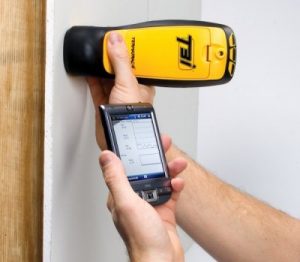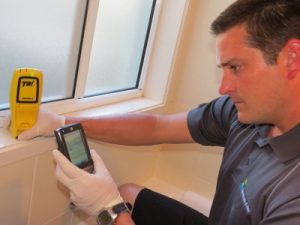
Gassing, fumigation, burning, electrocution – there are many ways to kill termites.
Yet, in the most approaches precise detection of all infested zones is crucial, and precise detection is impossible without proper technique and equipment.
Hide content
- What does a termite look like?
- The gear
- Where to look for termites?
- Technique of examination
- Useful articles
- Helpful video
- Conclusion
What does a termite look like?
Termite is a small insect sized of 3-25 mm. They can vary in shades of white, brown and black.The first step that should be done in the question of how to check for termites by yourself is searching detailed information about the appearance of termites. Representatives of three different social castes look different, but all of them (except the queen) have:
- soft bodies;
- three pair of legs;
- two straight antennae;
- thorax, subdivided into three sections;
- no eyes.
Termite workers have white, semi-translucent bodies. However, Drywood termites don’t have any ‘workers’ as such, the role of workers is played by immature soldiers and alates. THis information will be useful for you during termite detection process.
How to detect termite soldiers? Termite soldiers have:
- darker, bigger body;
- large mandibles.
How to find termite swarmers? This is how the swarmer looks like:
- straight waist (unlike ants who have thin waist);
- wings of the same size (two pairs of ants’ wings are different).
Now, when you have an idea of how to find termites in your house, let’s speak about how does its’ queen look like? Termite queen looks more like a fat white caterpillar.
Learn more about drywood termites: signs of their activity; best methods of treatment: spot treatment and DIY methods; how to get rid of them in furniture?
In the section below we will be speaking about how to check for termites in your home and in walls with the help of simple available means.
The gear
This device can become an indispensable assistant in termite check procedure. Here is the list of basic items you need in order to have a full inspection of any building you are looking for termites:
- flat-bladed screwdriver;
- bright flashlight;
- pencil;
- clipboard;
- tape measure;
- graph paper.
Besides, these items will also come in handy:
- hard hat;
- gloves;
- coveralls;
- prybar;
- hammer;
- ladder.
Professionals also use such equipment as:
- moisture meter;
- thermal imaging camera;
- microwave pestfinder;
- termite-sniffing dog.
All about termite detection tools.
Learn more about subterranean termites: signs of their activity; best methods of treatment and DIY methods. Eastern subterranean termites and their tunnels and tubes with photo.
Keep in mind that there are many other special equipment for checking termites but this one you could make by yourself without any help.
Where to look for termites?
This is the long list of all places to check:
- Exterior walls.
- Attic floor.
- Baseboards. Look for cracks; they may indicate moisture or feeding damage. Pry them back to look more thoroughly.
- Sill plates. Probe them with the screwdriver.
- Joists. The same as above.
- Cracked foundation.
- Cracked slabs.
- Porches.
These places demand special attention, for they are proved to be maybe the most susceptible to termite attacks of all.- Walls adjacent to garages and additions.
- Floors.
- Ceilings. Here where you’ll need the ladder.
- Walls, especially walls made of:
- stone,
- concrete,
- cinder blocks,
- hollow tile,
- brick,
because they may develop cracks, through which termites can pass.
- Window sills, where they often shed their wings.
- Window/door trims. Pry them back to make sure.
- Wood partition walls.
- Foundation walls made of hollow-blocks. Termites can easily make their way right through the voids in them towards wooden items.
- Paint and wallpapers bulges. Termites can eat paper, but usually leave paint behind.
- Paneling and wallboard. Pay attention to ripples.
- Books. open each one of them and turn the pages over (poking with a screwdriver is not required).
- Spider webs, where wings and alates may be caught.
- Places by leaky pipes and leaky roof, because termites like moisture.
In fact, you should check all places where water accumulates. You can see what places are especially moist by water stains. Most of other places like that have already been listed above.- Bathrooms should be checked for the same reason.
- Chimneys.
- Places with structural sagging, buckling, or settling.
- Sheathing of eaves.
- Vents.
- Any timber on the ground outdoors:
- tree stumps
- logs
- fallen trees
- gazebos
Here you can learn more information about effective treatment method called tenting (fumigation): dangers for termites, preparing for fumigation and cleaning after, how long does this procedure last?
Technique of examination
How to detect termites in your home, wood, walls and other furniture?
- Put on your hat, gloves and coverall.
- Prepare constructing an accurate scale drawing of your house with the writing tools.
- Take your flashlight and a hammer and start searching for signs of infestation all around.
- Tap all the wooden things with the hammer.
- Listen to the sound of the tapping. If it can be described as ‘hollow’ or ‘dull’, it means that they are probably there.
- Also at this stage you can check things with a reliable moisture meter. Moisture level exceeding 20% may well mean termite infestation in the depth.
- Besides, you may use thermal imaging camera. Look for hot-spots, these may well be their nests.
- One more gizmo for a true termite exterminator is a microwave pestfinder that can detect movement inside the wall.
- It’s unlikely that you’ll buy, borrow or train a termite-sniffing dog, yet some professionals do.
- Probe the place with a screw driver to make sure.
If it falls into subsurface without any effort, it means that the item has been eaten out.- Since subterranean termites may leave no signs of infestation, in order to find them you’ll have to tap all the wood, accessible via mud tubes (contacting to the soil) regardless of its outlook.
Useful articles
If you interested in more information of termites we recommend you to read the following articles:
- All types of termites. Are they harmful to humans? Can they bite you? And what is the difference between drywood and subterranean ones?
- What does swarmers of different species look like: drywood, subterranean, formosan?
- Signs of infestation outside and in the house: in walls or furniture.
- What does termite holes look like? What is droppings and is it toxic to humans? Do termites make noises?
- Posible termite damage, how does it look like? Examples of damage in walls and wood floors.
- All about flying termites: how do they look like, swarming season and what to do if there are swarmers in your house?
- How do they do nests and mounds? How to find it in your garden or inside the house?
- Termite life cycle – from egg to larvae.
Helpful video
Watch video below on how to detect termites in your home with and without special termite detectors:
Conclusion
In sum, what you need to do to detect termites is tapping all the wood within the house and beyond. Hollow sound means termites infestation.
If you poke the area with a screwdriver to make sure and see white translucent creatures, you should know that these are them – the termites you’ve been looking for.
Except for a hammer to tap and a screwdriver to probe you can grab some professional devices, such as microwave pestfinder or thermal imaging camera, but it requires some expertise to use.








